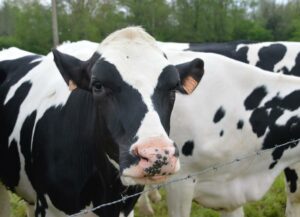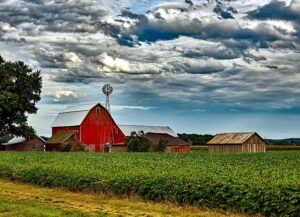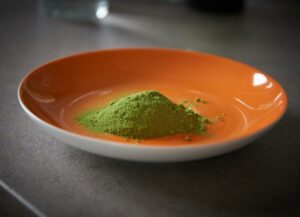Francisco E. Contreras Govea
Alfalfa, either for silage or hay, is the primary legume forage for diet formulation of lactating dairy cows in the United States. It is well documented that alfalfa nutritive value decline as maturity stage change from bud to flowering, finding that 10% blooming as the optimal time for harvesting, because of the intersection between nutritive value and forage yield (Orloff and Putnam, 2008).
However, in other countries, like China, where dairy industry is booming and high nutritive value forages are in high demand, alfalfa represents a very attractive crop. Therefore, alfalfa forage management information needs to be adapted or developed for these particular environmental conditions.
In a study conducted at the Shanxi Agricultural University (Taigu, China), alfalfa was harvested at three maturity stages: budding, initial and full flowering stages, first and second growing cycles for two consecutive years. Alfalfa was ensiled and fermented for a minimum of 40-days. The authors (Guo et al., 2019) analyzed fiber quality before and after fermentation.
Alfalfa nutritive value before ensiling
Alfalfa dry matter (DM) content ranged from 18.5 to 24.7%, increasing as maturity stage changed (Table 1). Crude protein declined from 21.8 to 19.3% DM as maturity increased from buddy to full flowering. In the contrary, neutral and acid detergent fibers (NDF and ADF) increased as maturity increased. Similar trends have been reported in previous studies harvesting at similar maturity stages (Orloff and Putnam, 2008; Palmonari et al, 2014). Such as differences in nutritive value have been reported as the effect of higher proportion of stem than leaves as maturity progress and stem lignification increase (Orloff and Putnam, 2008).
Table 1. Nutritive value of alfalfa when harvested a three different maturity stages.
| Maturity Stage | |||
| Bud | Initial blooming | Full blooming | |
| Guo et al. (2019) | |||
| Protein, % DM | 21.7 | 20.1 | 19.4 |
| NDF, % DM | 32.4 | 34.5 | 37.3 |
| ADF, % DM | 22.7 | 24.4 | 26.3 |
| NDF digestibility 48 h, % NDF | 41.2 | 40.9 | 40.1 |
| Palmonari et al. (2014) | |||
| Protein, % DM | 20.8 | 17.3 | 17.0 |
| NDF, % DM | 41.0 | 40.4 | 41.3 |
| ADF, % DM | 32.3 | 31.6 | 31.5 |
| Lignin, % DM | 6.3 | 6.9 | 7.3 |
| NDF digestibility 24 h, % NDF | 44.0 | 37.8 | 34.0 |
| NDF digestibility 240 h, % NDF | 62.2 | 57.5 | 55.7 |
Harvesting alfalfa for silage or hay to preserve nutritive value can have pros and cons. In Guo et al. (2019) study, alfalfa was ensiled at each maturity stage, but it was not wilted to the recommended DM content of 30-35% (Kung and Shaver, 2001). Therefore, silage fermentation was compromised resulting in very high pH (> 5.0), acetic, propionic, and butyric acids and low lactic acid concentrations (Table 2). Under these conditions dry matter digestibility and NDF digestibility were relatively low, even when harvested at very immature stage.
In a different study (Palmonari et al., 2014), alfalfa was cured for hay. Under these management conditions NDF and ADF was not different among maturity stages, but lignin concentration increased as maturity progressed (Table 1). In addition, indigestible NDF also increased as maturity stage changed, which could explain that NDF digestibility decreased as alfalfa maturity stage increased. By using these values in a diet formulation of lactating cows, Palmonari et al (2014) were able to predict a difference of 2.8 kg de milk/day between bud and full maturity stage.
Table 2. Fermentation profile of alfalfa harvested at three maturity stages
| Maturity stage | DM % | pH | Ammonia-N (% N) | Lactic acid, % DM | Acetic acid, % DM | Butyric acid, % DM |
| Bud | 20.4 | 5.40 | 15.1 | 2.73 | 2.75 | 0.47 |
| Initial blooming | 22.8 | 5.40 | 12.3 | 2.81 | 2.42 | 0.12 |
| Full blooming | 24.4 | 5.10 | 8.4 | 3.51 | 1.85 | 0.05 |
The take home message:
- Differences in protein, NDF, and ADF could be expected when harvesting alfalfa at early and late maturity, but the main effect would be in lignin and indigestible NDF, which will have a major impact on NDF digestibility.
- Either harvesting alfalfa for silage or hay at any maturity stage, should follow the recommendations of ensiling or bailing at specific DM content to reduce the risk of bad preservation conditions.
- The authors from the Chinese study concluded that harvesting alfalfa a bud stage had a “better silage quality”. We should be cautious about this information. As I mentioned before, alfalfa was ensiled at very low DM content. The pH and ammonia-N were very high which ended up in a silage fermentation that potentially could compromise rumen health.
References:
- Guo, G., C. Shen, Q. Liu, S. L. Zhang, C. Wang, L. Chen, Q. F. Xu, Y. X. Wang, and W. J. Huo. (2019). Fermentation quality and in vitro digestibility of first and second cut alfalfa (Medicago sativa) silages harvested at three stages of maturity. Animal Feed Sci. and Technology. 257.
- Kung, L. and R. Shaver. 2001. Interpretation and use of silage fermentation analysis reports. Focus on Forage Vol 3: 13.
- Orloff, S. B. and D. H. Putnam. 2008. Harvest strategies for alfalfa. In: C. G. Summers and D. H. Putnam. Irrigated alfalfa management. Chapter 13:197-207. University of California, Agriculture and Natural Resources. Publication 3512.
- Orloff, S. B. and S. C. Mueller. 2008. Harvesting, curing, and preservation of alfalfa. In: C. G. Summers and D. H. Putnam. Irrigated alfalfa management. Chapter 14:209-225. University of California, Agriculture and Natural Resources. Publication 3512.
- Palmonari, A., M. Fustini, G. Canestrari, E. Grilli, and A. Formigoni. 2014. Influence of maturity on alfalfa hay nutritional fractions and indigestible fiber content. J. Dairy Sci. 97:7729-7734.
© 2019 Dairy Knowledge Center, LLC. All Rights Reserved.









